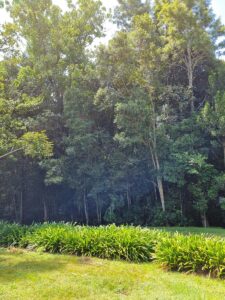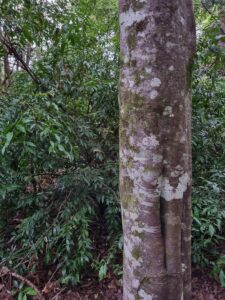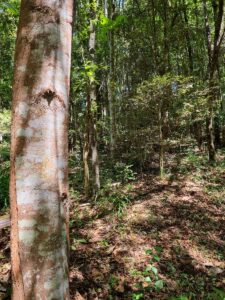Miyawaki afforestation – an appraisal
By Patrick Regnault
On social media, radio and television programs, the Miyawaki afforestation method is lauded as a solution to the environmental crisis and land degradation. Akira Miyawaki was a botanist and expert in plant ecology who developed a method of rapid reafforestation using native endemic species. His method relies on practical steps which have to be followed to succeed. It is a sound method which can be used to create good ecological reserves if used on appropriate sites. The method however is, like all methods, not infallible and should not be promoted without a critical eye.

Like all methods it can be misunderstood and misappropriated. To call 50m2 or 100m2 a forest is stretching the meaning of the word. A parcel of land over 5000m2 can be considered a forest if the tree cover is sufficient, anything less is a wood or a grove. This may seem like a technical difference to some but if we use science as a selling point, definitions are important.
The Method
As in all good planting, understanding the soil is a prerequisite to see what needs to be done to improve it and which plants to choose.
Plant species used must be native endemic plants suited to the topography and local conditions as those species will already be adapted to the site and will require little care.
The soil is prepared to a depth of 500mm to 1m with a good layer of compost of organic origin, thoroughly and deeply incorporated into the soil. Micorrhyzal fungi are added to the root ball prior to planting.

Plants are planted closely together, at 3 trees per m2 in temperate regions, and 10 trees per m2 in tropical regions to achieve faster growth by forcing them upwards, reducing the time to obtain semi-mature planting and green cover. Trees of different species are planted, incorporating an under storey. No two trees of the same species are to be planted next to each other. After planting, a thick layer of mulch is added to reduce water loss.
It is recommended to water and weed the plot for up to two years to remove competition and improve rooting.
Disadvantages
The first three steps are basic and are good horticultural practice, logical and reasonable. Where the problem starts is in the close planting which is likely to lead to competition for nutrients and space. Growing so close together, the trees will grow fast but are more likely to end up with long, weak trunks, smaller leaves due to longer internodes, and suffer from chlorosis. An etiolated tree is more easily damaged by wind, and pests are more likely to be attracted to a weak tree. Closely planted trees in large numbers have to compete fiercely for nutrients and if extra nutrients are not supplied during the first ten or so years, deficiencies will show and weaken the trees further. In the long-term weaker plants will not make it, resulting in survival of the fittest.
The initial cost is very high but this is offset by a faster rate of growth and reduced maintenance in the longer term, although a regular check to avoid invasive plants brought in by the wind or bird droppings, and to check on any nutrient deficiency is required.
The emphasis on plant species may diminish the need to also consider plant families if biodiversity is taken as an important factor. Not all plants are suited to this method and thoughtful consideration should be given to their physiological characteristics in the medium and long term.
The close planting results in mortality, according to research, of 10 to 85% and the tightness of space limits animal circulation.
It seems that for larger degraded land areas the method is really effective but is it wise to use it for small plots? Is the greater speed of growth worth a weaker tree and greater plant fatalities? Using the same soil preparation, but planting 1.5m apart with a fine balance of understorey, and with space to grow, would achieve the same result over 20 years. Have we reached a time where we do not want to accept nature’s time frame and that impatience is the driving force? I will leave you with a quote from 1866 by Hyacinthe Loyson: “These trees which he plants and in whose shade he will never sit, he loves them for themselves and for his children, and for his children’s children, over whom their branches will spread.”
Patrick Regnault FAIH RH0062
Interactive Landscapes
E: patrickregnault@hotmail.com
Main photo: The trunks of the same forest have a diameter ranging from 200mm to 400mm depending on the species (Image: Patrick Regnault)

